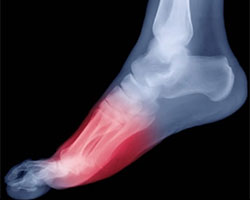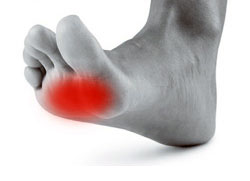- Home
- Foot & Ankle Conditions
- Metatarsalgia (ball of foot pain)
Metatarsalgia: symptoms, causes and treatments
- Published 6/1/2018
- Last Reviewed 11/20/2024

What is Metatarsalgia?
Metatarsalgia often referred to as "ball of the foot pain" or a "stone bruise" is not so much a condition but a general term describing a group of foot problems whose symptoms are caused by several conditions.
In some cases, there can be more than one condition causing metatarsalgia symptoms. This is just one of several reasons why a proper diagnosis can be challenging and why the experience of your doctor is such a critical part of diagnosis and getting a successful treatment plan from the start.
-
Foot and Ankle Surgeon at University Foot and Ankle Institute
Dr. Justin Franson, DPM, is a Board Certified Podiatric Foot and Ankle Specialist and Diplomate of the American Board of Podiatric Surgery. He attended the School College of Podiatric Medicine in Chicago, graduating in 2001. Dr. Franson then accepted a three-year residency program at the Greater Los Angeles VA and UCLA County Hospital.
Dr. Franson specializes in several areas including total ankle replacement and sports medicine. Treating athletes and weekend warriors like himself brings him a lot of joy. Dr. Franson keeps active with running marathons, triathlons, hiking, basketball, and golf.
Metatarsalgia articles from our blog
 I was very happy with the staff and the Doctor. I found the Doctor on the internet and sent a request for a consult through the...Kathleen V.
I was very happy with the staff and the Doctor. I found the Doctor on the internet and sent a request for a consult through the...Kathleen V. I liked it.Liisa L.
I liked it.Liisa L. I depend on the doctors at UFAI to provide cutting edge treatments. Twice, I have traveled from Tucson, Arizona to get the car...Jean S.
I depend on the doctors at UFAI to provide cutting edge treatments. Twice, I have traveled from Tucson, Arizona to get the car...Jean S. They helped me in an emergency situation. Will go in for consultation with a Dr H????
They helped me in an emergency situation. Will go in for consultation with a Dr H????
Re foot durgeryYvonne S. It went very smoothly.Maria S.
It went very smoothly.Maria S. My experience at the clinic was wonderful. Everybody was super nice and basically on time. Love Dr. Bavarian and also love the ...Lynn B.
My experience at the clinic was wonderful. Everybody was super nice and basically on time. Love Dr. Bavarian and also love the ...Lynn B. I fill I got the best service there is thank youJames G.
I fill I got the best service there is thank youJames G. My experience with your practice far exceeded any of my expectations! The staff was always friendly, positive and informative. ...Christy M.
My experience with your practice far exceeded any of my expectations! The staff was always friendly, positive and informative. ...Christy M. Very happy. When the office found out my insurance was not in network they totally worked with me to pay them. Everyone I inter...Deb C.
Very happy. When the office found out my insurance was not in network they totally worked with me to pay them. Everyone I inter...Deb C. Dr. Chan is superb. Appointments have always gone smoothly here. Definitely worth the visit.J.P. Y.
Dr. Chan is superb. Appointments have always gone smoothly here. Definitely worth the visit.J.P. Y. Love Dr. Johnson.Emily C.
Love Dr. Johnson.Emily C. I am a new patient and felt very comfortable from the moment I arrived to the end of my visit/appointment.Timothy L.
I am a new patient and felt very comfortable from the moment I arrived to the end of my visit/appointment.Timothy L.



